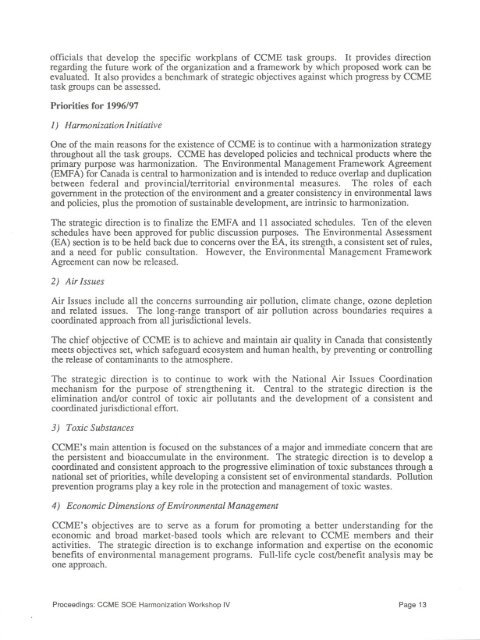CCME State of the Environment Reporting Harmonization Workshop ...
CCME State of the Environment Reporting Harmonization Workshop ...
CCME State of the Environment Reporting Harmonization Workshop ...
Create successful ePaper yourself
Turn your PDF publications into a flip-book with our unique Google optimized e-Paper software.
<strong>of</strong>ficials that develop <strong>the</strong> specific workplans <strong>of</strong> <strong>CCME</strong> task groups. It provides direction<br />
regarding <strong>the</strong> future work <strong>of</strong> <strong>the</strong> organization and a framework by which proposed work can be<br />
evaluated. It also provides a benchmark <strong>of</strong> strategic objectives against which progress by <strong>CCME</strong><br />
task groups can be assessed.<br />
Priorities for 1996/97<br />
1) <strong>Harmonization</strong> Initiative<br />
One <strong>of</strong> <strong>the</strong> main reasons for <strong>the</strong> existence <strong>of</strong> <strong>CCME</strong> is to continue with a harmonization strategy<br />
throughout all <strong>the</strong> task groups. <strong>CCME</strong> has developed policies and technical products where <strong>the</strong><br />
primary purpose was harmonization. The <strong>Environment</strong>al Management Framework Agreement<br />
(EMFA) for Canada is central to harmonization and is intended to reduce overlap and duplication<br />
between federal and provincial/territorial environmental measures. The roles <strong>of</strong> each<br />
government in <strong>the</strong> protection <strong>of</strong> <strong>the</strong> environment and a greater consistency in environmental laws<br />
and policies, plus <strong>the</strong> promotion <strong>of</strong> sustainable development, are intrinsic to harmonization.<br />
The strategic direction is to finalize <strong>the</strong> EMFA and 11 associated schedules. Ten <strong>of</strong> <strong>the</strong> eleven<br />
schedules have been approved for public discussion purposes. The <strong>Environment</strong>al Assessment<br />
(EA) section is to be held back due to concerns over <strong>the</strong> EA, its strength, a consistent set <strong>of</strong> rules,<br />
and a need for public consultation. However, <strong>the</strong> <strong>Environment</strong>al Management Framework<br />
Agreement can now be released.<br />
2) Air Issues<br />
Air Issues include all <strong>the</strong> concerns surrounding air pollution, climate change, ozone depletion<br />
and related issues. The long-range transport <strong>of</strong> air pollution across boundaries requires a<br />
coordinated approach from all jurisdictional levels.<br />
The chief objective <strong>of</strong> <strong>CCME</strong> is to achieve and maintain air quality in Canada that consistently<br />
meets objectives set, which safeguard ecosystem and human health, by preventing or controlling<br />
<strong>the</strong> release <strong>of</strong> contaminants to <strong>the</strong> atmosphere.<br />
The strategic direction is to continue to work with <strong>the</strong> National Air Issues Coordination<br />
mechanism for <strong>the</strong> purpose <strong>of</strong> streng<strong>the</strong>ning it. Central to <strong>the</strong> strategic direction is <strong>the</strong><br />
elimination and/or control <strong>of</strong> toxic air pollutants and <strong>the</strong> development <strong>of</strong> a consistent and<br />
coordinated jurisdictional effort.<br />
3) Toxic Substances<br />
<strong>CCME</strong>'s main attention is focused on <strong>the</strong> substances <strong>of</strong> a major and immediate concern that are<br />
<strong>the</strong> persistent and bioaccumulate in <strong>the</strong> environment. The strategic direction is to develop a<br />
coordinated and consistent approach to <strong>the</strong> progressive elimination <strong>of</strong> toxic substances through a<br />
national set <strong>of</strong> priorities, while developing a consistent set <strong>of</strong> environmental standards. Pollution<br />
prevention programs play a key role in <strong>the</strong> protection and management <strong>of</strong> toxic wastes.<br />
4) Economic Dimensions <strong>of</strong> <strong>Environment</strong>al Management<br />
<strong>CCME</strong>'s objectives are to serve as a forum for promoting a better understanding for <strong>the</strong><br />
economic and broad market-based tools which are relevant to <strong>CCME</strong> members and <strong>the</strong>ir<br />
activities. The strategic direction is to exchange information and expertise on <strong>the</strong> economic<br />
benefits <strong>of</strong> environmental management programs. Full-life cycle costlbenefit analysis may be<br />
one approach.<br />
Proceedings: <strong>CCME</strong> SOE <strong>Harmonization</strong> <strong>Workshop</strong> IV Page 13
















